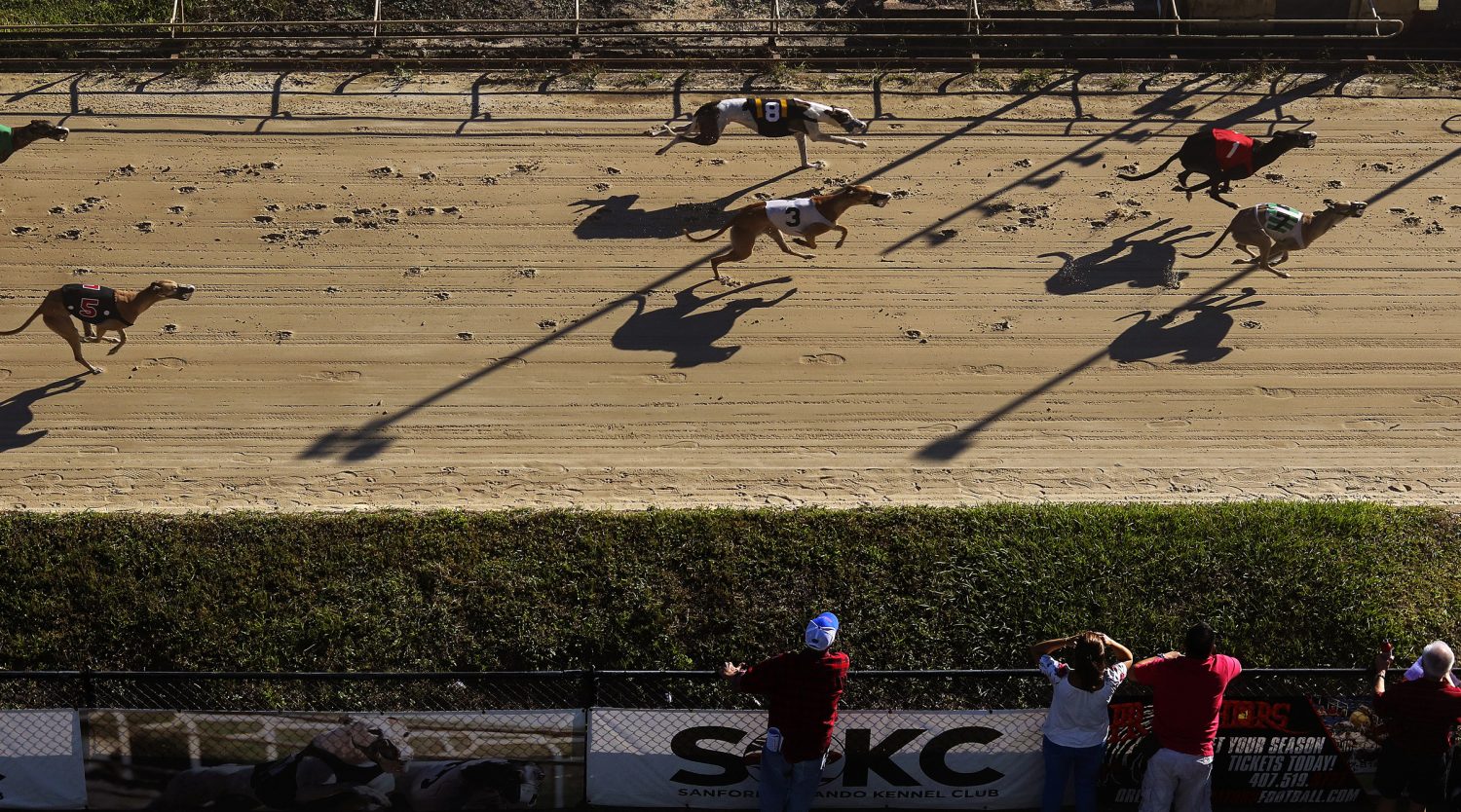January 27, 2020Longwood, Florida — The Sanford Orlando Kennel Club was once mythic, part of a long history of greyhound racing in Florida. The sport of queens.
Spectators paid 25 cents to pack the pastel blue bleachers of the grandstand. Thousands of locals, tourists and celebrities, dressed in their finest, came to watch the dogs run. Among the 2,000 guests on opening night in 1935 was Amelia Earhart. The Orlando Sentinel reported the famed aviator was unphased by a flight across the Atlantic but thrilled at the sight of the speedy dogs. Rumor has it that even Elvis visited the Sanford track; he liked to sit in Box 1, in front of the floor-to-ceiling windows that afforded him the fullest views of the majestic hounds.
Sanford was once a place for dreaming. Dog racing was a different kind of gamble. Out on the track, it was just the dogs and the lure. There was no jockey to force a last-minute victory. Anyone could place a bet, and anyone could get lucky and leave with a fatter wallet.
But by the time I arrive at the Sanford track in October, its end has begun.
I’m an equestrian and in my childhood, my family owned retired racehorses. I’m a dog owner who also fosters abandoned pups of all sizes and breeds. But I’ve never been to a horse race. Nor to a greyhound track.
I’ve read accounts of dog racing in its heyday. I’ve seen the old photos taken at a time when the grandstands were packed. But what I see on my visits is something vastly different.
The greyhounds still sprint around the track twice as fast as Usain Bolt. They make money for owners, gamblers and track employees for whom dog racing is a way of life. But decades after Earhart and Elvis came and watched, the sport is fading.
Though dog racing brought endless joy to some, it meant grave discomfort for others who saw it as antiquated, an addiction and animal cruelty. Its novelty dulled with the proliferation of tracks and the advent of online gambling.
The death knell came in November 2018, when Floridians overwhelmingly voted to end greyhound racing. Amendment 13 not only banned the sport, but made it constitutionally illegal. That meant all 11 of the Sunshine State’s greyhound tracks would have to close their doors by the end of this year. Both racing fanatics and animal rights activists assure me the greyhounds will find safe homes after they leave the tracks. Adoption groups say the waiting lists for dogs are long.

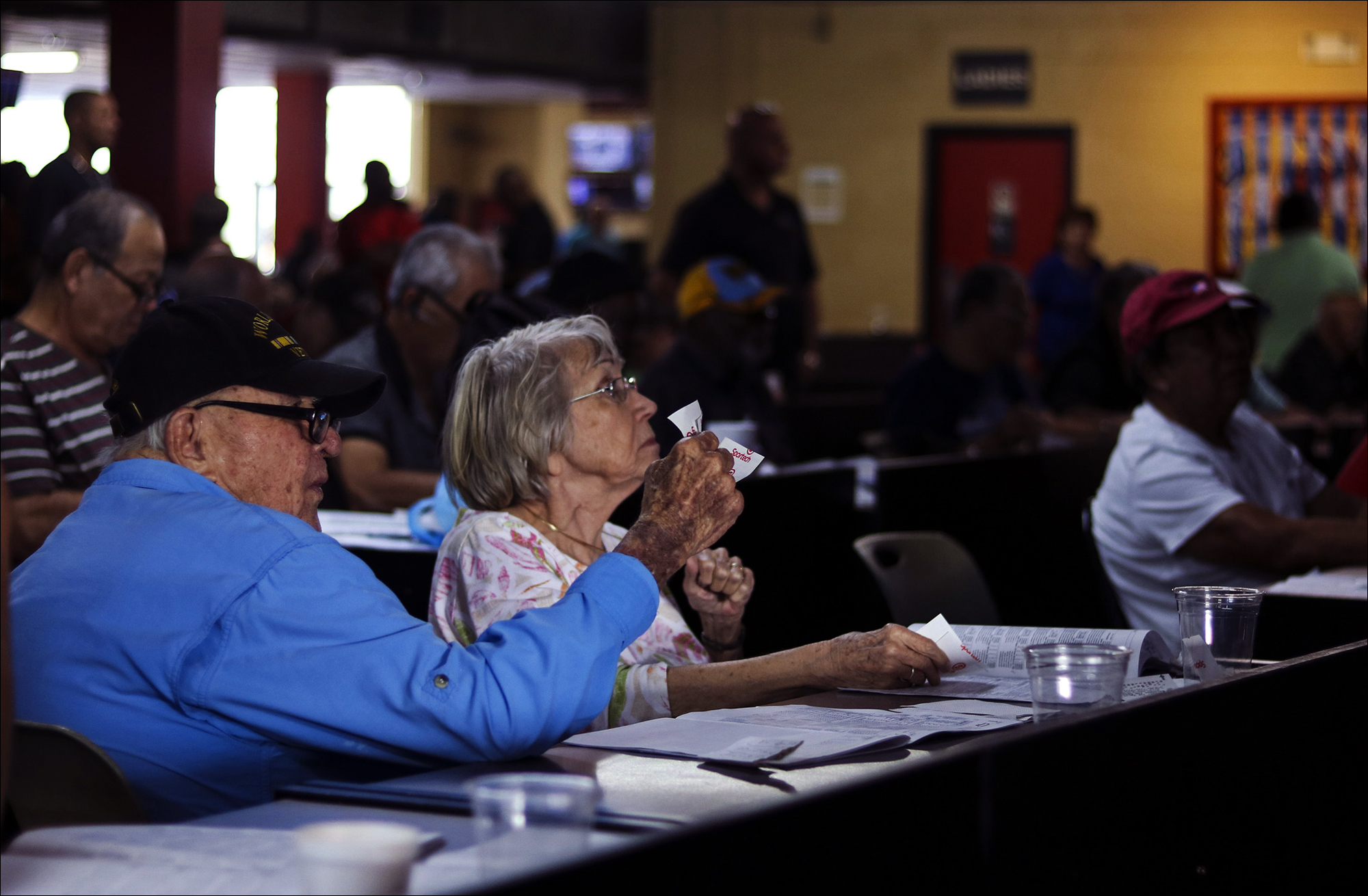

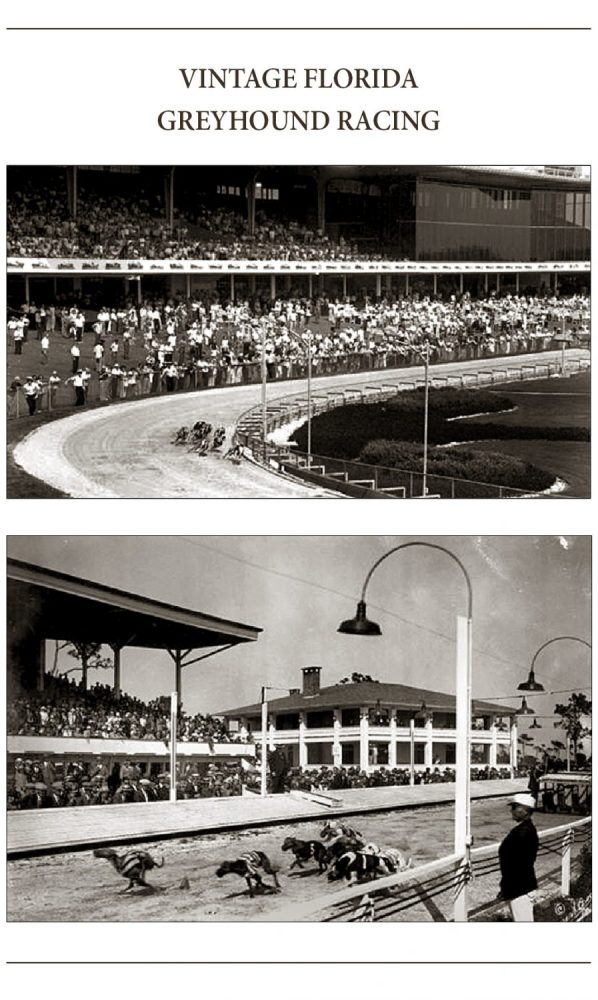
But the ban is sure to snuff out the livelihoods of thousands of Floridians who depend on some aspect or another of dog racing. Greyhound trainers are independent contractors; they will not get retirement or severance pay. For many, it’s a family business that has been their lifeblood for generations. Most of them don’t have college degrees – they never even thought about doing anything else. The employees I meet at Sanford are losing their harbor.
And soon.
Already, six tracks have called it quits. The other five are trudging towards the end as the December 31 deadline looms. Sanford plans to stay open until June, but the crowds are long gone. The track, just 15 miles north of downtown Orlando, draws on average about 40 people; maybe 300 on a good day.
General Manager Mitch Cohen shows me where he believes Elvis once sat in the now-shuttered grandstand. All that’s left are windows bearing gaping holes and bleachers blanketed by dust and chunks of decaying ceiling. The only people in the betting room are gamblers with silver hair and hearing aids. The bar has a few patrons watching the races on television screens while sipping on beers or Cokes that they swear are sweeter here. They seem oblivious to the crumbling grandstand above them. If they did, maybe they’d see it as an omen.

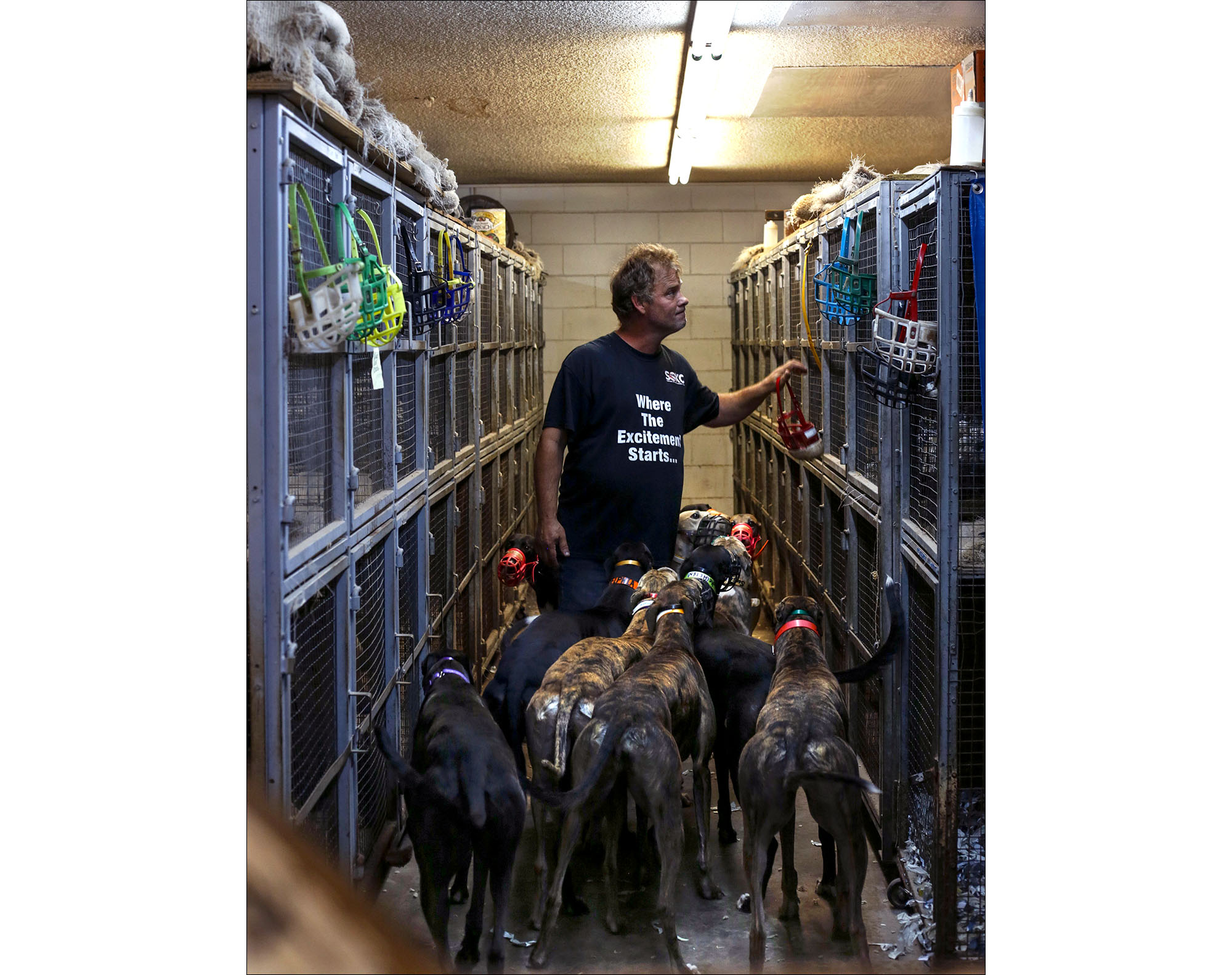
Labors of love
The chaos of a fall morning is overwhelming when owner A.J. Grant first brings me to Celtic Hounds, one of seven kennels across the street from the Sanford track. Stacks of crates – 80 in all — line every wall, packed in and connected like LEGOs. There are dogs everywhere. They dart in and out of the crates and a sand pen outside where they can run around. They go inside, outside, then back inside again.
Arthur “Art” Marcoux, the trainer, has been here since 5:30, before sunrise, managing the canine circus. He’s busy in the kitchen, throwing meat and kibble together. The food has to be weighed to a science and the bedding has to be cleaned every morning – some shaken out, some washed.
I watch him administer medication to some of the dogs and treat their cuts or broken nails.
Marcoux is exactly the type of man I pictured would be working here; burly, beer-bellied, with a graying beard and receding hairline. He’s gruff and leathery from the Florida sun, but laughter lines and warm blue eyes soften him. He tore all the tendons in his right ankle after he fell off a 10-foot ladder and now limps from crate to crate as he cares for the dogs.
They are his babies. It’s his responsibility to listen to them, to notice if they’re sick or hurt. They can’t tell him, after all. He sees greyhound trainers as the barrier between hounds and the hands of time – as long as greyhounds can run, they won’t go extinct.
Marcoux surveys his pack. Bordeaux whines until Marcoux throws her a hash brown from his own breakfast. Chi Scarlet needs a banana on racing days or she’ll get cramps. Rollin’ goes crazy if Marcoux plays the Limp Bizkit song by the same name, leaping and twisting in the air.
At 46, Marcoux has never known a life without greyhounds. They’ve been his paycheck for more than three decades – and so much more. They’re his pride.
The road to one’s success is paved through the labors of love these dogs give to us. It’s important not to forget that.
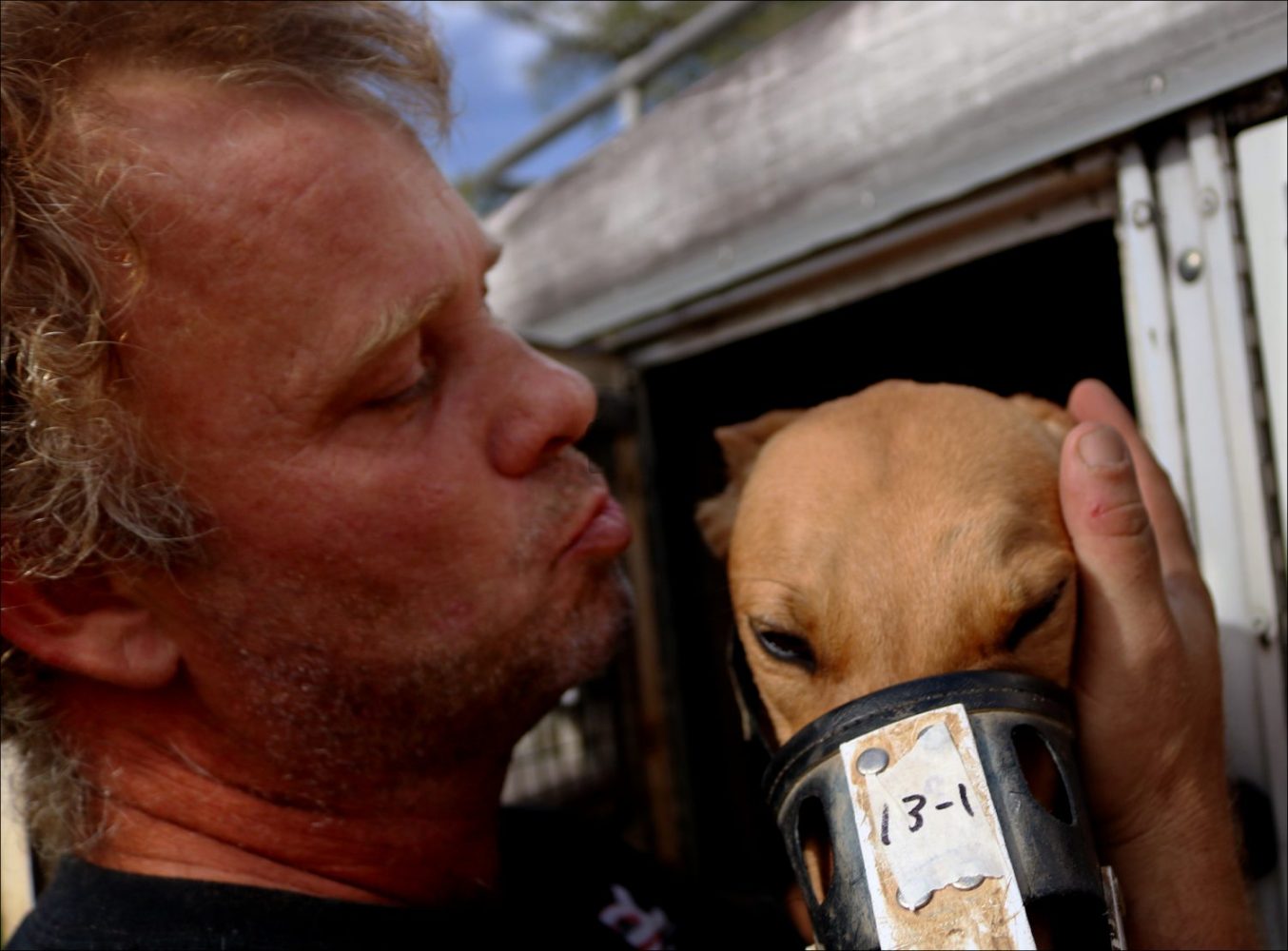
He has admired greyhounds since he was 7, when his father first took him to a track. He was awed by their speed and beauty. When he was a lanky, blond 14-year-old, he acquired a part-time job as a lead-out at a New Hampshire track. He took the dogs from the clubhouse to the starting gate for the races every afternoon. Later, he became a trainer and began working at the Sanford track four years ago. He teaches his dogs many things but out on the field, a greyhound tells its own story.
One, Tony Altomare, was 5 and nearing retirement when he was thrown into a marathon race. But he pulled out with a huge lead and won.
“He showed us [that] he loved what he did, and he gave it all, one last time,” Marcoux tells me. “The road to one’s success is paved through the labors of love these dogs give to us. It’s important not to forget that.”
He gives his heart, they give theirs. In a sport based on stealth and speed, he says, there’s only one muscle that really matters.
But now, with the demise of the sport, Marcoux faces an uncertain future.
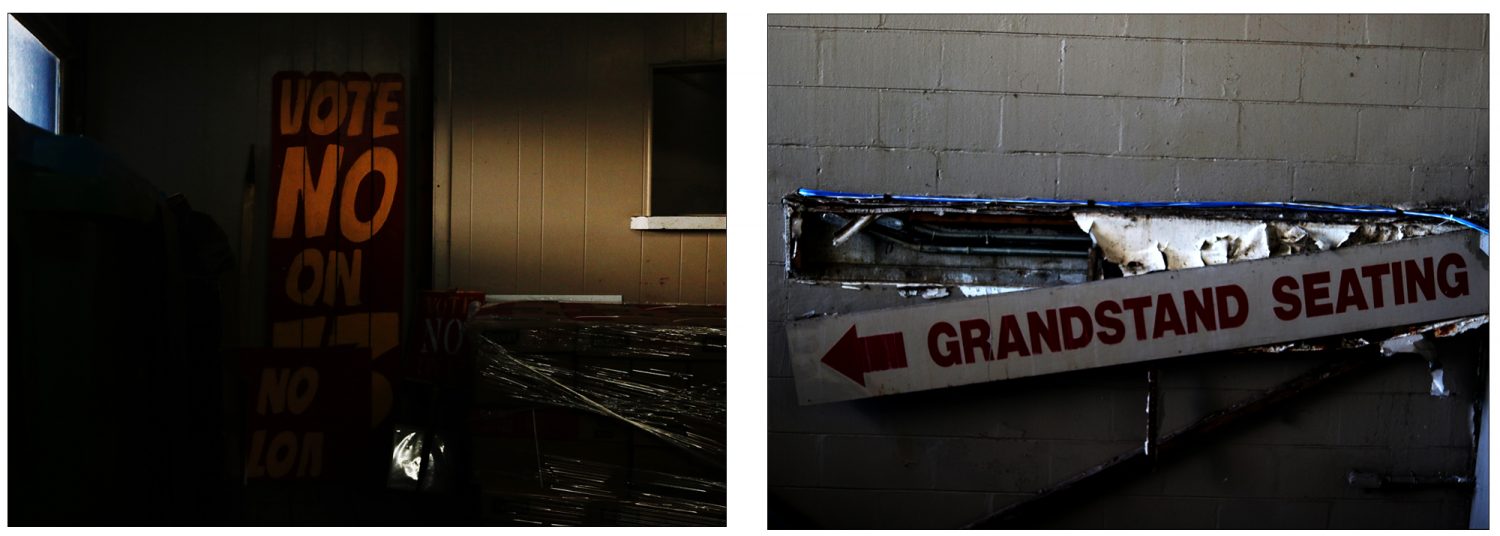
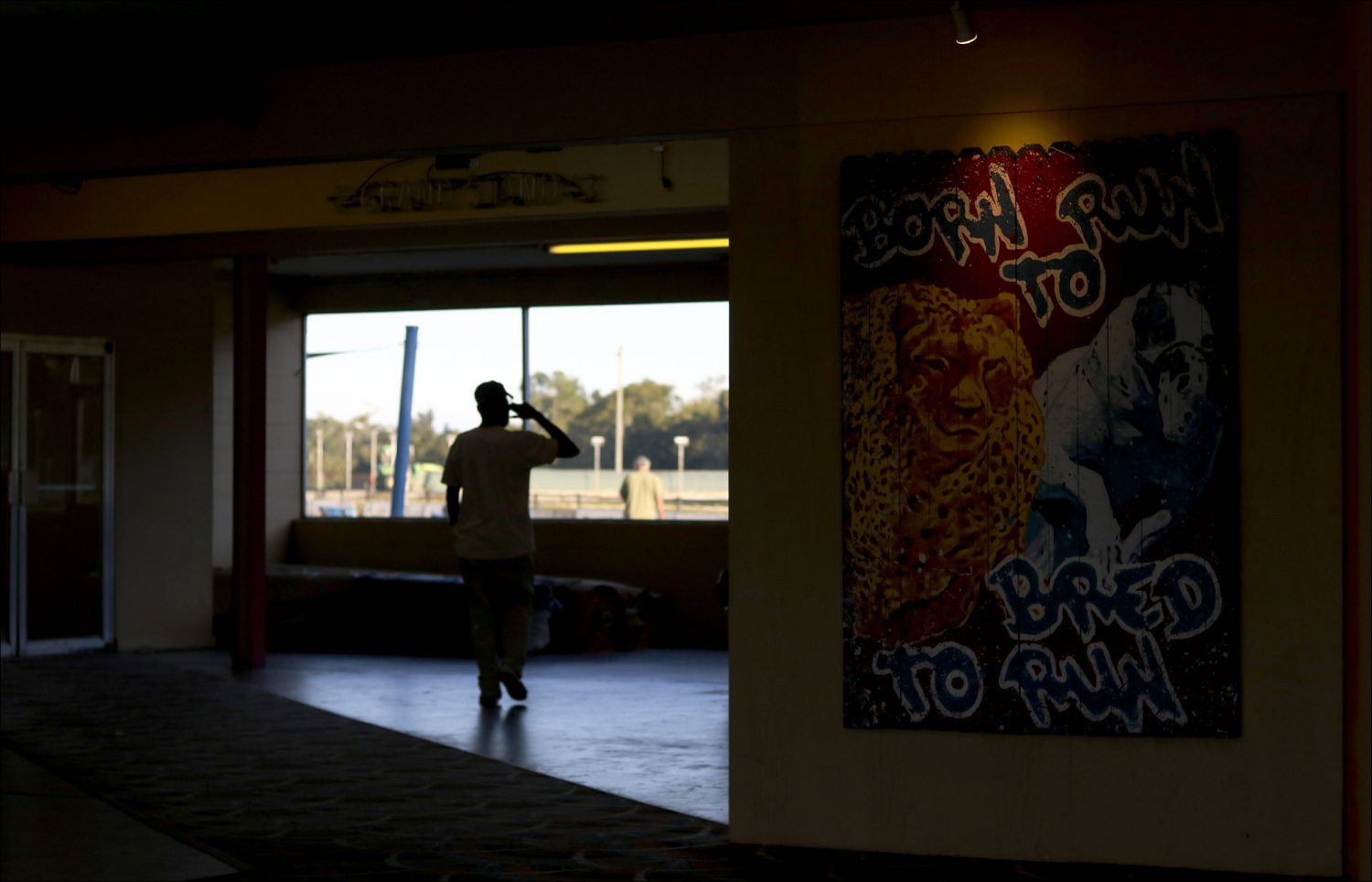
He once tried the 9-5 office routine, when he was taking care of his ailing parents. He tried to work in the tech world and even fixed computers for Apple.
“Going back to that would be a vacation,” he says. Motherboards, however, weren’t his thing; he needed to hear a dog’s heartbeat.
But now he may be forced to consider a similar job. He and his daughter, Brittany Benoit, who works at the kennel with him, are the sole earners for a family that has swollen to include his wife’s parents and his two grandchildren. In all, Marcoux takes care of seven people, one adopted greyhound and two cats.
Outside the kennel, far from earshot of Marcoux, Grant admits it won’t be easy for Marcoux and his family once the track closes.
“I worry about Brittany,” Grant tells me. “She has two kids, you know? After this, she might have to go on food stamps.”
He can’t help imagining her working in a gas station or doing some menial job that would dim her smile. And what would she do with her hair that she dyes to match the collars of her favorite dogs?
Grant muses about the end for a moment. He had considered retiring soon. He might’ve passed the kennel down to Marcoux, who has been the spine of his kennel. But his plans don’t matter anymore.

An ancient breed
At the sand turnout, I watch the dogs romp and play. It’s important to Grant, Marcoux and all the other employees at Sanford that I see this. “Antis,” as greyhound folks call the anti-racing community, argue the dogs never see the light of day.
The hounds are bony but big at 60 or 70 pounds. At Celtic Hounds, one dog called Smote weighs a whopping 90 pounds.
Greyhounds are bred to have hearts as big as a human’s and half as much body fat as a household pet. Their legs are stick-like and their skin, paper thin. They are an ancient breed, the only ones mentioned in the Bible. But sometimes, they almost seem like aliens.
A black and white dog gets excited, jumps and almost knocks me over. I feel the sheer power of these animals and wonder if I could force a greyhound to run, even if I wanted to.
“If we abused them, would they be that friendly?” Grant asks, raising a fiery issue that has long consumed the sport.
Animal rights groups like GREY2K USA and the racing community have battled for years on whether greyhounds at racing tracks are ill-treated. Activists argue the hounds are susceptible to horrific injuries and then tossed like garbage or worse, euthanized, when they can no longer run. Some are drugged and mistreated. I have seen state records that show as much. And the track workers don’t deny that these things happen.
But they believe it’s unfair to blame everyone in the racing industry for what they say are a few bad incidents. Marcoux feels he has a perennial target on his back, and the “antis” are always trying to take a shot.
In a few hours, Marcoux will be taking his dogs to the track for the 15 races scheduled this afternoon. That’s the part that everyone who voted to ban the sport has seen: muzzled hounds chasing a mechanical lure around a dirt track.
Soon the dogs will stop running. Marcoux dreads the day when the kennels will become another artifact, collecting dust just like the old clubhouse. In this moment, he’s trying hard not to think about that; two dozen dogs are waiting to go to the track. I watch him put one foot in front of the other.

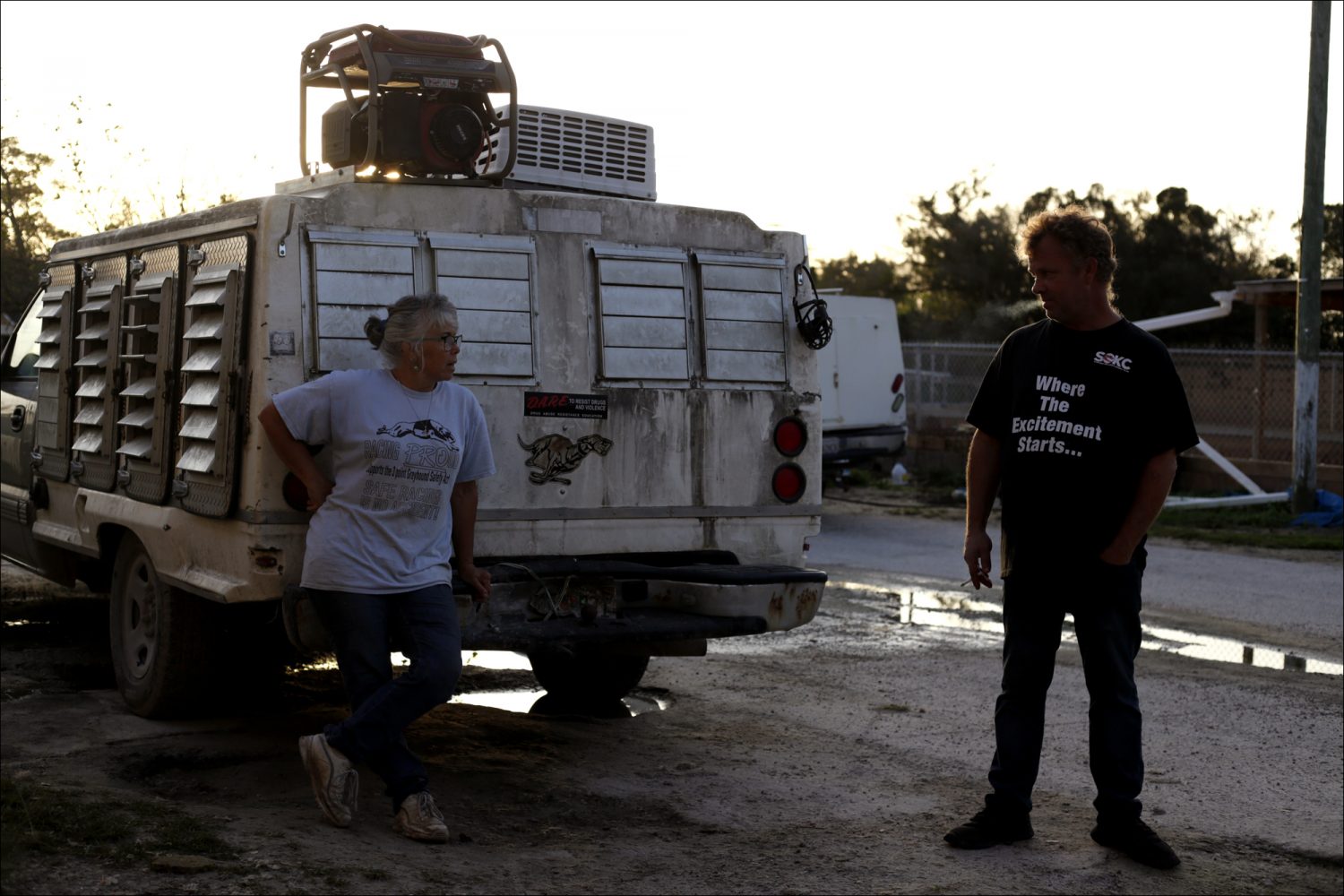
The elephant in the room
On a damp November afternoon, Marcoux loads four to eight dogs at a time onto his old green Ford F-250. He installed kennels and air conditioning in the back.
It’s a bumpy ride on Dog Track Road as they circle Lyman High School, where greyhounds serve as proud mascots. Then they park and the dogs jump out of the truck and drag Marcoux with them towards the clubhouse.
Grant greets Marcoux at the door. He looks over his shoulder, grinning at me.
“They say we’re bad people. If they just spent some time with us, they’ll see, we’re just people.”
“They hate this, right?” he jokes, one of his constant jibes at anti-racers.
He and his girlfriend, Kathi Lacasse, have worked with Marcoux for years. Marcoux met Lacasse, who trains dogs for Bolton Racing next door, at a New Hampshire track in the 1980s. They were even roommates once. But in Orlando, they spend every day together. They’ve become family.
The three take their dogs inside and get them weighed. Then, the dogs wait for their turn to race.
Once the races begin, Marcoux heads to the lobby to chomp on a cheesesteak or burger and fries with a soda to wash it down. He trades dog stories with Grant and Lacasse. The couple have two tripods, dogs who needed a leg amputation after racing injuries. Marcoux likes to talk about how his greyhound, Teddy, fiercely protects his granddaughter Ophelia.
What Marcoux never discusses with his friends is the finality of it all. It’s the elephant in the room. Except maybe in a joke or two, aired to relieve the tension.
“Maybe we can go to Disney in June,” Grant laughs. “We’ll all be unemployed anyway.”
They talk about antiquing, moonshine, Metallica and Lacasse’s spotted Appaloosa pony. They make dinner plans and exchange stories about what the dogs do when no one is watching.
“They say we’re bad people,” Grant tells me. “If they just spent some time with us, they’ll see, we’re just people.”
Born to run
Marcoux scans the day’s racing program, calculating the odds for his dogs, then debates those odds with his friends. He bickers with Lacasse over which kennel will rule the day.
Marcoux knows which dogs can “find the hole,” and break through the pack for the win. Which ones are scared to pass and need a clear path. Who likes the inside, who likes the outside.
In the 10th race of the day, Marcoux will be rooting for his dog, H.L.’s Honey. At the start of her career, Honey could run a pretty good race. She was fast and consistent. At 4, age has slowed her down, and she hasn’t won in two months. Her racing comments, recorded to help guide people who are placing bets, have gone from “fast finish win,” to “never prominent,” and “away fast, faded.”
Marcoux has watched Honey’s stats decline and thought about retiring her. On this dreary day, he stands beside a chain-link fence to keep a close eye on her.
The methods of greyhound racing changed over the years but the core of the sport remains the same as it was in the Middle Ages, grounded in an ancient hunting technique known as “coursing.” In coursing, fast dogs, mainly hounds, chased and hunted down rabbits, foxes, and hares.
These days, the sport is less bloody – the bait animals replaced by mechanical lures. But the hunting instincts of the dogs are the same.
Marcoux watches as a pack of dogs are led into their starting boxes. Honey is Number 4. The announcer yells his signature, “Here comes swifty!” and the gates fly open, releasing six barreling hounds.
The dogs hit the ground low and hard, kicking up clouds of sand. They can run up to 45 mph, slower than a cheetah but faster than a thoroughbred. They are clueless to the stakes. Greyhounds are just born to run.
At first, Honey’s got her eye on the lure, stuck in a tight pack of four. One starts to pull ahead, and the line of dogs becomes more linear, with Honey’s blurry form in fourth or fifth place. She still has a chance.
The dogs are so fast that each race only lasts 33 seconds. Look away and you’ll miss the thrill. Marcoux and I watch the hounds speed around the turn, and then, suddenly, Honey drops back.
Marcoux’s heart sinks. He already knows what Lacasse voices.
“That’s a broken hind leg.”
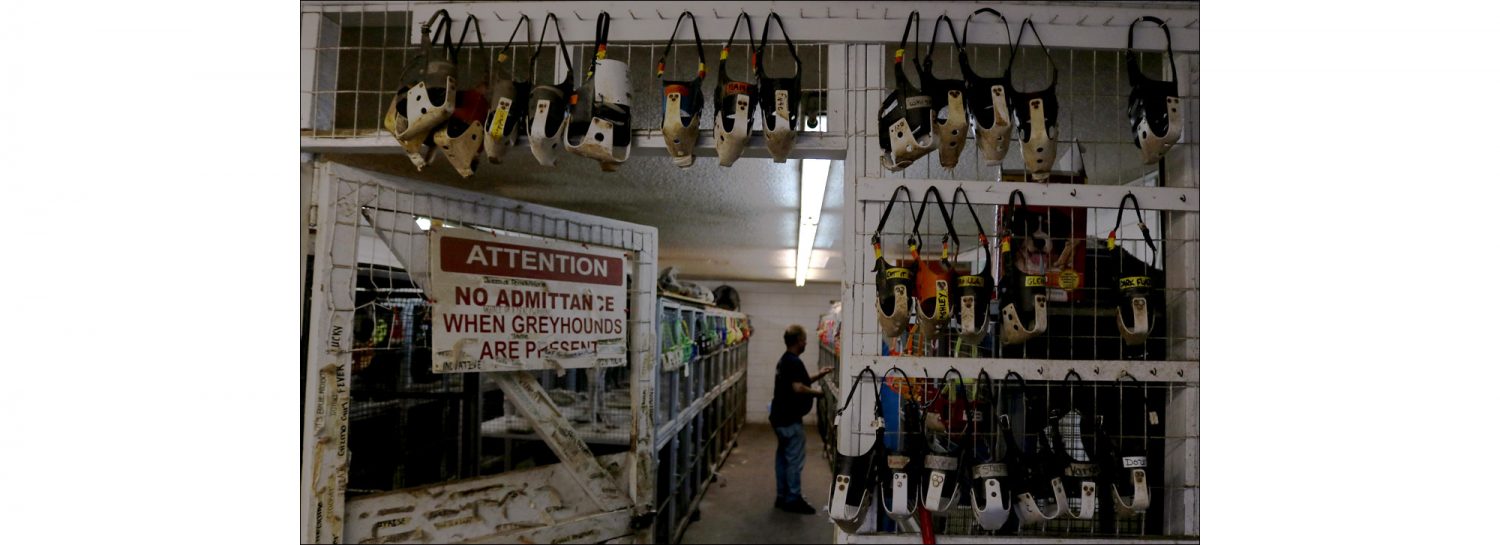
Where careers end
Time stills.
Marcoux knows what this means for Honey.
He won’t ever be leading her to the track again. No more walking her through the cooling pool. No more sips of cold water from old cans that once held syrupy peaches.
I hang back, trying not to get in the way. This is the moment that animal rights activists loathe.
Marcoux has told me that injuries are common, just as in any other sport. Like football stars and Olympic gymnasts, dogs either bounce back or retire.
The lead-out picks Honey up when the limping dog finally crosses the finish line. Marcoux rushes towards her. He takes her into his own arms as though she were a newborn.
“She’ll be alright,” he says, carrying her to the track’s veterinarian, Jerry Schrader.
“Broken leg?” Schrader asks, opening the door to his on-site office, a stark room with an examination table in the middle. A box brims with miniature casts; hindleg injuries are common.
“Broken leg,” Marcoux echoes.
His face is solemn. He has brought Honey to the place where careers end.
He knows this is the part of the story people talk about. It’s a huge reason why Florida voted to ban racing. But Marcoux won’t let harm come to Honey or any of the dogs he trains.
He’s lost count of how many he’s taken under his care over the course of his career. But he remembers how each dog’s story began. He’s the first person to touch them. He watches them turn from cuteness to stealthy athletes. As they age, he looks for signs they are ready to stop running. And when they retire, he’s the one who loads them onto the truck and says goodbye.
He’s seen Honey since she was 16 months old, a black and white ball of fur, when she was clumsy and skittish.
Now, in the vet’s office, he wishes he had retired her sooner.
Honey is shaking, whimpering softly and trying to evade the vet.
“She’s high strung,” Marcoux says.
He pets her flank and finally, she relaxes.
“It’s alright, baby, it’s alright,” he tells her again and again.
I can see his veil of toughness falling away.
Schrader sets Honey’s leg. Marcoux leans over and kisses her forehead.
He carries her back to his truck and lifts her gently into her crate. Then he gets on the phone to call the woman who arranges adoptions for Celtic Hounds. When Honey leaves, he’ll pull her tag off her crate and stick it on a kennel wall that bears the names of all those who have gone before her.
Goodbyes are a part of the racing culture. Dogs come and go. Marcoux can’t keep them all, no matter how attached he gets. He’s learned to be stoic. He grabs his program and walks back to the track. There are still five races left.
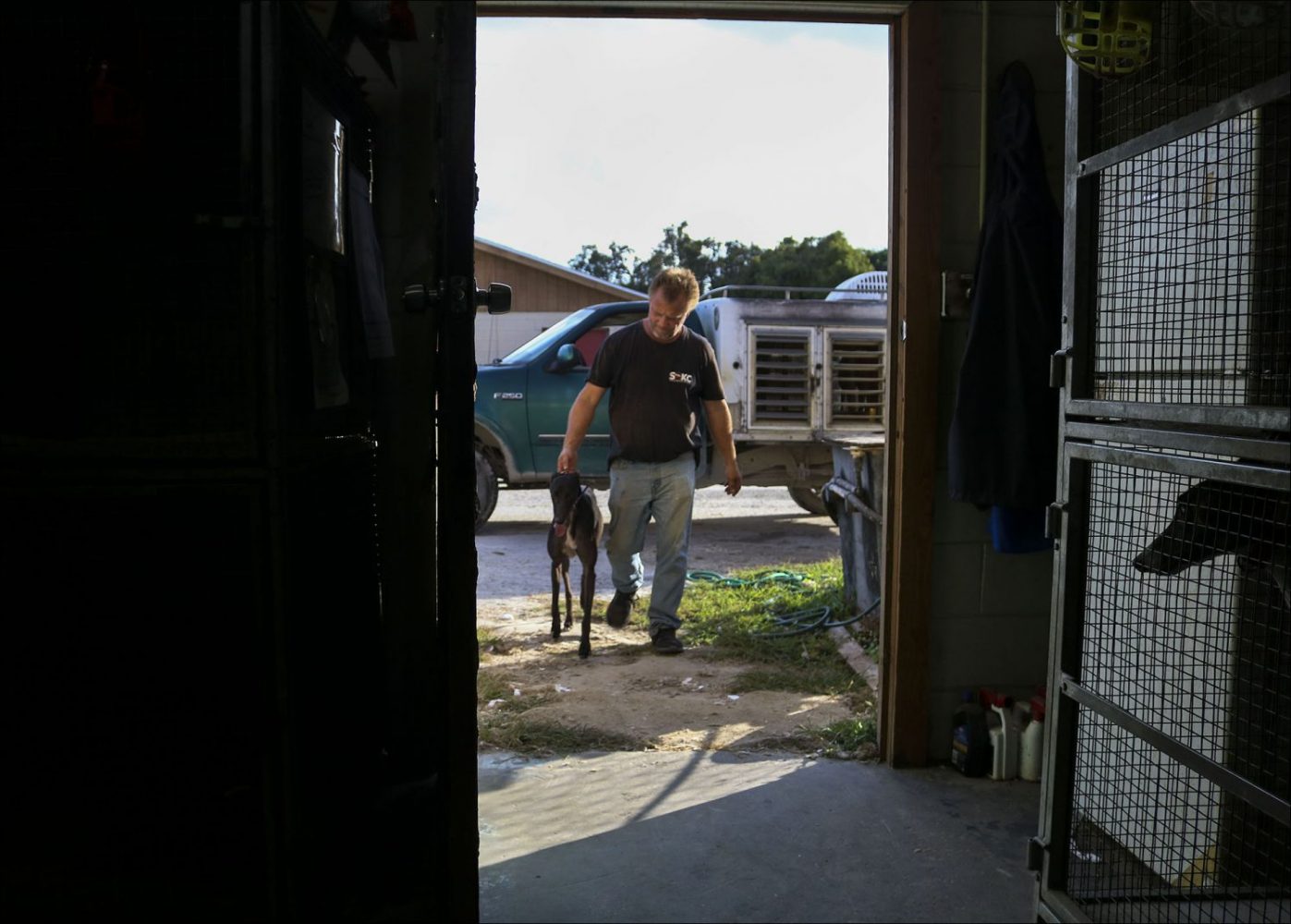
Broken dreams
Marcoux wonders which dog will be the very last he loads onto his truck. He won’t know that until the final race at Sanford but a date has not even been announced yet.
When Amendment 13 made its way to the ballot, Marcoux attended meetings and hit street corners with signs to save the track. He brought dogs with him, hoping to show the public that the canines at his kennel were well-mannered and loved, not abused.
He remembers the day in November when Floridians went to the polls. He had just returned to Orlando after burying his mother. He drove from the airport straight to the track to wait for the outcome of the vote. He had been so sure that Amendment 13 would be defeated. He was wrong. Soon, he would no longer be training dogs.
He doesn’t talk about it much. When he does, he struggles to get the words out. He had dreams of his granddaughter Ophelia working here; she loves to come to the track. Ever since he brought Teddy home, she’s been obsessed with greyhounds. He sees the same fire in her eyes that once flashed in his.
But now those dreams are gone.
Greyhound careers lasts five years at most. Some, like Honey’s, get cut short by forces beyond their control. Marcoux, even with his faulty ankle, has been going strong for years. He, like his dogs, would keep going if he could.
But when that last day comes, no one will be here, at this fabled Florida track, to save him.
 Special Report from WUFT News
Special Report from WUFT News

